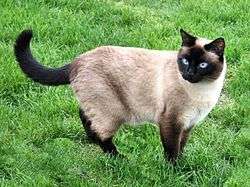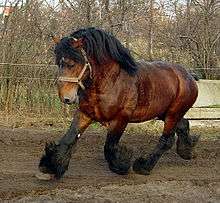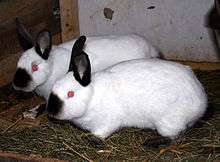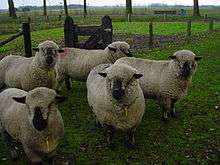Point coloration

Point coloration refers to animal coat coloration with a pale body and relatively darker extremities, i.e. the face, ears, feet, tail, and (in males) scrotum. It is most recognized as the coloration of Siamese and related breeds of cat, but can be found in rabbits, rats, sheep, and horses as well.
In cats

Point coloration in cats originated in the Siamese and closely related Asian breeds, and is found in many Western-developed modern breeds. It is a form of partial albinism resulting from a mutation that affects tyrosinase, an enzyme involved with melanin production. The mutated enzyme is thermolabile; it fails to work at normal body temperatures, but becomes active in cooler areas of the skin.[1] As a result, dark pigment is limited to the coldest areas of the body, that is, the extremities. Pointed kittens are born white, since the womb is uniformly warm. As the kitten ages, the cooler areas darken while warmer areas remain cream to white in color. Points are not limited to solid colors or dark colors. It is possible to have a red (orange color) or fawn (pale warm gray) point. It is also possible to have a tortoiseshell or tabby point. This coloration is also sometimes called colorpoints.
As the expression of the gene responsible for the pointed pattern is regulated by temperature, pointed cats who live in cooler environments often show darkening of their fur, with large patches along their sides sometimes developing.
Because of this restriction of pigment, pointed cat's eyes are always some shade of blue, because the top layer of the iris is not covered in another color, letting the blue show through. The back of the eye also lacks pigment, giving these cats' pupils an eerie red reflection in the dark, unlike a normally pigmented cat's green to blue shine.
The point gene is carried on the C locus, where pure albinism is also carried. It is shown with the sign cs, and needs two alleles of cs for the points to be expressed. Also carried on the C locus is the gene for the sepia pattern. This is the darkest of all of the pigment restricting patterns, and pigment is only paled at the warmest point in the body, the abdomen. This pattern's gene is represented by cb. When a cat carries the genes cs and cb, the mink pattern is formed, in which the pigment distribution is between a sepia and a point cat.
The lynx point pattern is formed by cross-breeding a colorpoint cat with a tabby cat (or breeding cats that already possess the lynx point pattern). It is characterized by a mixture of the darkening (reduced) of point coloration, with distinct tabby striping on the head, tail, and legs, and an otherwise uniform and comparatively pale body. It is an accepted pattern, in some cat registries but not others, for particular breeds, mostly Siamese-related.[2] Lynx point coloration was also a feature of some of the foundation stock of the Siberian.[3]
Breeds
In horses


In horses, point coloration is produced by the action of the Agouti gene, which acts on the extension gene, when present, to suppress black color to all but the extremities of the horse; the legs, mane, tail and tips of the ears. If the extension gene is not present, the effect of agouti is not visible, as there is no black color present to suppress. Points are most typically seen on a bay-colored horse, which has a black mane, tail, legs and ear tips while the body and head will show the underlying chestnut or "red" base color. Point coloration may also be visible on horses with dilution genes that act upon a bay base coat such as the dun gene and a single copy of the cream gene. Other genes or white markings may affect a horse's coat color in addition to agouti, and if present, can further alter or suppress black hair color and may mask any point coloration. Any horse breed may have point coloration with the exception of a very small number of horse breeds where humans have specifically used selective breeding to eliminate the agouti gene.
Coat colors with visible points
In rabbits
The classic, pointed white rabbit, as seen in the Himalayan rabbit breed, is created by the ch gene. Sable points, Seal points, Blue Points, Chocolate Points, Lilac Points, Siamese, Pearl, and Sallander do not have the ch gene, which can be seen because they lack the red eyes of true pointed white rabbits. Those colors are created by the cchl, cchd, or cchm gene in conjunction with the e gene. Pointed White rabbits were first seen in the Himalayan breed, and are now seen in the Californian breed, but are accepted varieties in many breeds, including the French Angora, English Angora, Satin Angora, Jersey Wooly, Netherland Dwarf, Holland Lop, Mini Rex, Rex, Satin, Mini Lop, and American Fuzzy Lop, and it is a color in development in Mini Satins. No pointed white Rabbit can produce orange pigment, the points are always black, blue, chocolate or lilac, sometimes in conjunction with white agouti, marten, broken, Vienna, or harlequin patterns, but these are not colors recognized for showing. All pointed white rabbits have red eyes.
Breeds

Sheep breeds

References
- ↑ D. L. Imes; et al. (April 2006). "Albinism in the domestic cat (Felis catus) is associated with a tyrosinase (TYR) mutation" (Short Communication). Animal Genetics. 37 (2): 175–8. PMC 1464423
 . PMID 16573534. doi:10.1111/j.1365-2052.2005.01409.x. Retrieved 2006-05-29.
. PMID 16573534. doi:10.1111/j.1365-2052.2005.01409.x. Retrieved 2006-05-29. - ↑ Exactly which registries accept lynx-point coloration, or other point coloration, at any given time is a moving target, best checked with awards searches at particular registries, e.g. a search for "lynx point" at the TICA website.
- ↑ TICA. "Siberian Introduction".
- ↑ "Highlander Cat Stats". Catchannel.com. Catster. Retrieved August 16, 2016.
